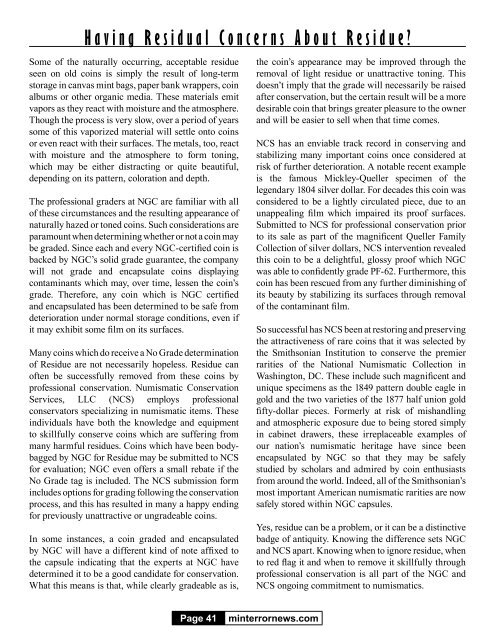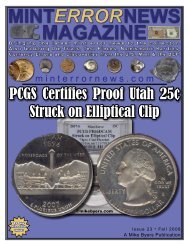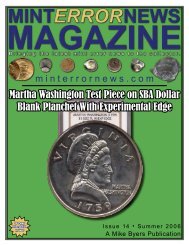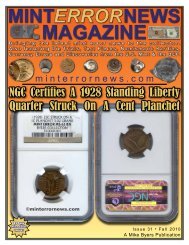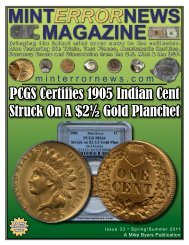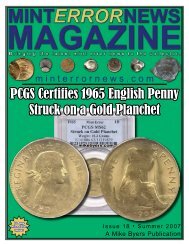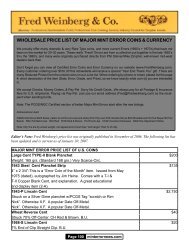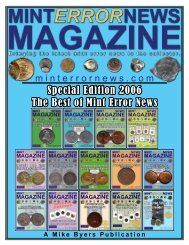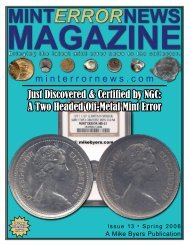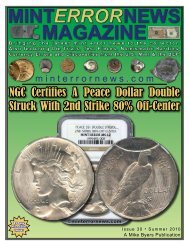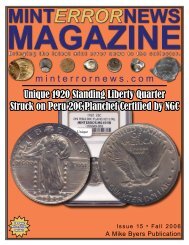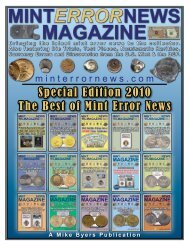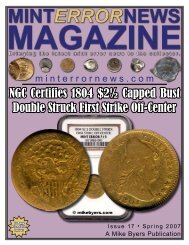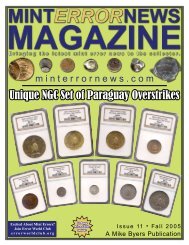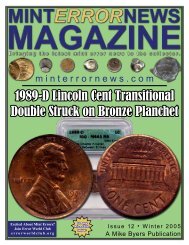Create successful ePaper yourself
Turn your PDF publications into a flip-book with our unique Google optimized e-Paper software.
Having Residual Concerns About Residue<br />
Some of the naturally occurring, acceptable residue<br />
seen on old coins is simply the result of long-term<br />
storage in canvas mint bags, paper bank wrappers, coin<br />
albums or other organic media. These materials emit<br />
vapors as they react with moisture and the atmosphere.<br />
Though the process is very slow, over a period of years<br />
some of this vaporized material will settle onto coins<br />
or even react with their surfaces. The metals, too, react<br />
with moisture and the atmosphere to form toning,<br />
which may be either distracting or quite beautiful,<br />
depending on its pattern, coloration and depth.<br />
The professional graders at NGC are familiar with all<br />
of these circumstances and the resulting appearance of<br />
naturally hazed or toned coins. Such considerations are<br />
paramount when determining whether or not a coin may<br />
be graded. Since each and every NGC-certified coin is<br />
backed by NGC’s solid grade guarantee, the company<br />
will not grade and encapsulate coins displaying<br />
contaminants which may, over time, lessen the coin’s<br />
grade. Therefore, any coin which is NGC certified<br />
and encapsulated has been determined to be safe from<br />
deterioration under normal storage conditions, even if<br />
it may exhibit some film on its surfaces.<br />
Many coins which do receive a No Grade determination<br />
of Residue are not necessarily hopeless. Residue can<br />
often be successfully removed from these coins by<br />
professional conservation. Numismatic Conservation<br />
Services, LLC (NCS) employs professional<br />
conservators specializing in numismatic items. These<br />
individuals have both the knowledge and equipment<br />
to skillfully conserve coins which are suffering from<br />
many harmful residues. Coins which have been bodybagged<br />
by NGC for Residue may be submitted to NCS<br />
for evaluation; NGC even offers a small rebate if the<br />
No Grade tag is included. The NCS submission form<br />
includes options for grading following the conservation<br />
process, and this has resulted in many a happy ending<br />
for previously unattractive or ungradeable coins.<br />
In some instances, a coin graded and encapsulated<br />
by NGC will have a different kind of note affixed to<br />
the capsule indicating that the experts at NGC have<br />
determined it to be a good candidate for conservation.<br />
What this means is that, while clearly gradeable as is,<br />
the coin’s appearance may be improved through the<br />
removal of light residue or unattractive toning. This<br />
doesn’t imply that the grade will necessarily be raised<br />
after conservation, but the certain result will be a more<br />
desirable coin that brings greater pleasure to the owner<br />
and will be easier to sell when that time comes.<br />
NCS has an enviable track record in conserving and<br />
stabilizing many important coins once considered at<br />
risk of further deterioration. A notable recent example<br />
is the famous Mickley-Queller specimen of the<br />
legendary 1804 silver dollar. For decades this coin was<br />
considered to be a lightly circulated piece, due to an<br />
unappealing film which impaired its proof surfaces.<br />
Submitted to NCS for professional conservation prior<br />
to its sale as part of the magnificent Queller Family<br />
Collection of silver dollars, NCS intervention revealed<br />
this coin to be a delightful, glossy proof which NGC<br />
was able to confidently grade PF-62. Furthermore, this<br />
coin has been rescued from any further diminishing of<br />
its beauty by stabilizing its surfaces through removal<br />
of the contaminant film.<br />
So successful has NCS been at restoring and preserving<br />
the attractiveness of rare coins that it was selected by<br />
the Smithsonian Institution to conserve the premier<br />
rarities of the National Numismatic Collection in<br />
Washington, DC. These include such magnificent and<br />
unique specimens as the 1849 pattern double eagle in<br />
gold and the two varieties of the 1877 half union gold<br />
fifty-dollar pieces. Formerly at risk of mishandling<br />
and atmospheric exposure due to being stored simply<br />
in cabinet drawers, these irreplaceable examples of<br />
our nation’s numismatic heritage have since been<br />
encapsulated by NGC so that they may be safely<br />
studied by scholars and admired by coin enthusiasts<br />
from around the world. Indeed, all of the Smithsonian’s<br />
most important American numismatic rarities are now<br />
safely stored within NGC capsules.<br />
Yes, residue can be a problem, or it can be a distinctive<br />
badge of antiquity. Knowing the difference sets NGC<br />
and NCS apart. Knowing when to ignore residue, when<br />
to red flag it and when to remove it skillfully through<br />
professional conservation is all part of the NGC and<br />
NCS ongoing commitment to numismatics.<br />
Page 41<br />
minterrornews.com


